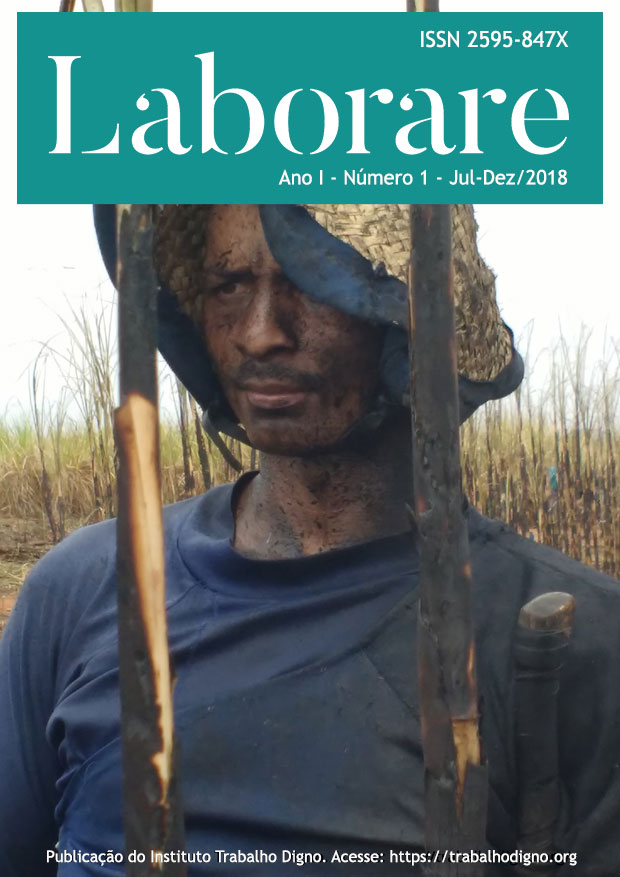Factor de riesgo: ruido normativo y silencio gubernamental
DOI:
https://doi.org/10.33637/2595-847x.2018-8Palabras clave:
direitos trabalhistas, Avaliação e tolerância aos ruídos, Saúde do trabalhadorResumen
Este artigo aborda de forma crítica e propositiva a inércia governamental quanto à necessária harmonização dos parâmetros, metodologia, procedimentos e limites de tolerância pertinentes ao fator de risco ruído. No âmbito do governo federal, há uma anômala bifurcação do ponto de vista jurídico-normativo, bem como técnico-procedimental de avaliação e tolerância ao ruído, pois o que vale para a Receita Federal do Brasil - RFB e Instituto Nacional de Seguro Social - INSS não vale para o Ministério do Trabalho MTb, de forma que o direito à redução no tempo de contribuição para 25 anos junto ao INSS e o respectivo recolhimento pela empresa à RFB, de 6% da remuneração do trabalhador, seguem regra da NHO-01 da Fundacentro, enquanto o pagamento de adicional de remuneração pela empresa (20% do salário mínimo) ao trabalhador adota o anacrônico, evasivo e equivocado Anexo I da NR15. Faz-se um apanhado histórico, inclusivo normativo, que contextualiza e explica o procedimento fiscal e o reconhecimento de direitos adstritos ao ruído. Discorre-se sobre a definição e significados dos principais parâmetros de avaliação (Critério de Referência - CR, Fator de Dobra (q) e Nível Limiar de Integração - NLI). Apresentam-se exemplos práticos que evidenciam as consequências nefastas ao trabalhador decorrente desse barulho normativo proveniente da temerária vigência do Anexo I da NR 15. Finalmente, este artigo suscita soluções que harmonizam os atos normativos interministeriais, ao tempo que propõe retificações de normas do INSS que desrespeitam mandamentos superiores.
Descargas
Citas
Almeida, H. Influence of electric punch card machines on the human ear. Archives of Otolaryngology, n. 51, p. 215-222, 1950.
Vieira, K. G. Perda da força sofrida pelo arco do equipamento de proteção individual auricular tipo concha de acordo com o tempo de utilização. 2003. 73p. Monografia (Curso de Especialização em Engenharia de Segurança do Trabalho), Unesp, Bauru/SP, 2003.
Souza, N. S. S. Hipertensão arterial entre trabalhadores de petróleo expostos a ruído. Cad. Saúde Pública, v. 17, n. 6, p.1481-1488, nov/dez. 2001.
Andren, L. et al. Effect of noise on blood pressure and 'stress' hormones. Clinical Science, v. 62, p. 137-141, 1982.
HARLAN, W. R. Impact of the environment on cardiovascular disease: Report of the American Heart Association task force on environment and the cardiovascular system. Circulation, v. 63, p. 243A-246A, 1981.
Santos, U. P.; et al. Ruído: Riscos e Prevenção, 2° ed. São Paulo: Hucitec, 1996.
http://sislex.previdencia.gov.br/paginas/05/mtb/15.htm
ISO-1999/1990: The statement in the occupational exposure limit that the proposed OEL (85 dB(A)) will protect the median of the population against a noise-induced permanent threshold shift (NIPTS) after 40 years of occupational exposure exceeding 2 dB for the average of 0.5, 1, 2, and 3 kHz.
Artigo Técnico publicado pela Revista ABHO, Ano 9, Número 21, em Setembro/2010, além do enorme valor histórico, é revelador da saga brasileira contra a chaga social representada pelos acidentes do trabalho.
Limites de Exposição (TLVs) para Substâncias Químicas e Agentes Físicos e Ãndices Biológicos de Exposição (BELs). Tradução ABHO - Associação Brasileira de Higienistas Ocupacionais. Cincinnati, 1958. ACGIH - (American Conference of Governamental Industrial Hygiene).
Arcuri, A. S. A.; Cardoso, L. M. N. Limite de Tolerância? Revista Brasileira de Saúde
Ocupacional. 1991; p 19: 99-106
ACGIH - (American Conference of Governamental Industrial Hygiene), Documentation of the Threshold Limit Values and Biological Exposure Indices, 1976, v. 1 : p. 01-718.
Revista ABHO, Ano 9, Número 21. p9
The TLV®s used as reference by Brazilian law, was from ACGIH ®, 1976. ACGIH ® TLV”™s took into account the working day of 40 hours / week. 1978 NR”™s OEL”™s had to be adjusted for 48 hours / week. TLV”™s had to be reduced for Brazil at that time and were 22% lower than ACGIH due to this adjustment in 1978.
http://docplayer.com.br/22762023-Titulo-analisando-os-limites-de-tolerancia-brasileiros-autoras-teresa-cristina-nathan-outeiro-pinto-maria-cristina-esposito-silverio-p.html (2005). Acessado em 30 julho 2017.


